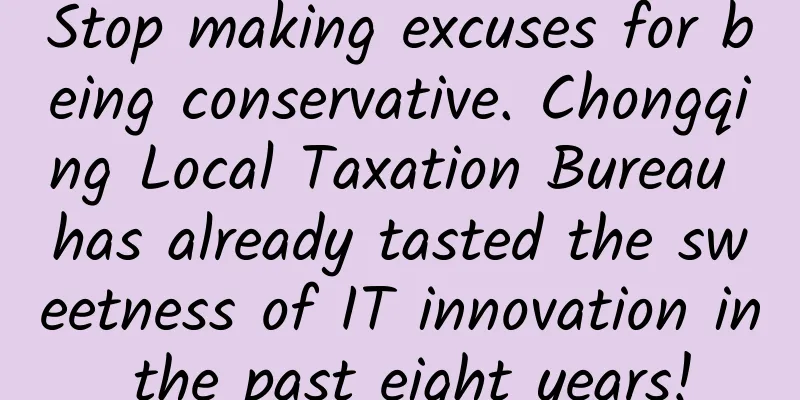Stop making excuses for being conservative. Chongqing Local Taxation Bureau has already tasted the sweetness of IT innovation in the past eight years!

|
Editor’s Note: The Chongqing Local Taxation Bureau's informatization development path is very typical. The dilemmas, difficulties and challenges they once encountered are still being experienced by many companies today. Their practical experience in virtualization can provide a very valuable reference for those relatively "conservative" companies. In 2013, Chongqing Local Taxation Bureau, as the first pilot unit in the third phase of the Golden Taxation Project, had to achieve a complete transformation of the taxation system in a very short period of time. It faced many problems, such as tight time for launch, lack of mature experience to learn from, multiple database system requirements, difficulty in one-time integration in a short period of time, and difficulty in accurately predicting the application performance requirements of various databases. In the end, Chongqing Local Taxation Bureau adopted virtualization technology to solve these problems one by one. Due to the hasty launch, the information system still has many problems. In the past three years, Chongqing Local Taxation Bureau has continued to optimize its infrastructure while also meeting new IT challenges: improving the security protection system, establishing a dual-active data center, and building a private cloud to support the production system...
Although the data center of Chongqing Local Taxation Bureau is only 700 square meters, its value is worth every inch of land. The tax network it carries needs to maintain real-time interconnection and information exchange with other government agencies and financial institutions at the horizontal level; at the vertical level, it needs to serve 740,000 taxpayers, and nearly 300 billion yuan of tax revenue, more than 80% of which is realized through the Internet. Undoubtedly, informatization has made great contributions to this. If we want to sort out the history of Chongqing local tax informatization, there are three very important time nodes: 2009, 2013 and 2016. They can also be described by three short sentences: walking on a tightrope in the air, daring to be the first, and willing to innovate. Tightrope Walking in 2009 Before 2009, Chen Huaijun's job was relatively easy. As the head of the Network Section of the Information Management Center of Chongqing Local Taxation Bureau at that time, he took advantage of the opportunity of Chongqing Taxation's centralized network transformation in 2007 to make significant adjustments to the taxation system's network and form a reliable closed loop. At that time, all video conferences, monitoring, transactions, and office work could be done online, the business demand was not large, business continuity was relatively stable, and the IT team had almost no pressure from the business. However, by 2009, the daily operation and maintenance of Chongqing's tax system was like walking on a tightrope. The machine systems purchased in 2001 were gradually aging, and IT operations were overwhelmed. When we wanted to upgrade an application, we found that the service provider had either changed jobs or the project manager and developer had resigned. Later, we finally transferred a service provider from Northeast China, but found that the previous operating system and software versions were too low, many drivers were incompatible, and even the CD-ROM installation could not be installed. In order to develop the project, Chen Huaijun and the technical team used PCs as a temporary substitute to start development and solve the problem before the server purchase application was approved. At the beginning, the demand was small and everything was fine. However, after the purchased servers arrived, the PCs were replaced for testing. Over the years, the 700-square-meter data center became a warehouse for PCs. These PCs were on the racks, which were not only unreliable, but also took up space and consumed electricity, and could crash at any time. "In order to ensure the continuity of service, the machines had to be installed only after get off work," Chen Huaijun recalled. "Often more than a dozen colleagues knelt on the floor of the computer room to install the machines, which took a few hours or even several nights. Sometimes the machines could not be installed properly, so they had to be re-standardized and re-installed. It often took several days and nights to complete the installation." 2013: A flash of inspiration for virtualization In 2013, Chen Huaijun first heard the word virtualization. The manufacturer told him that through virtualization, the system could be migrated to ensure the continuity of applications, which made him excited. However, after reporting to his leader, he received a lot of doubts, and even there were many opposing voices in the team. In the traditional thinking of leaders and colleagues, virtualization is software. Even the software giant Microsoft has to apply hundreds of patches every year, but it is still unstable. What’s more, the tax system has system software and application software. If virtualization software is added, once it becomes unstable and an accident occurs, the consequences will be too serious. In the end, Chen Huaijun withstood the pressure. They organized more than 30 people, proposed a safe and reliable solution, and demonstrated it to the leaders on site: in order to simulate the accident, they unplugged the network cable and the server power supply, but a few seconds later, the business was miraculously restarted, which was impossible in the past. This desperate solution finally won the approval of the leaders. Later, after testing, they finally adopted a rolling method for all servers and virtualized them all. Six months later, virtualization brings greater innovation Less than half a year later, the Information Center faced even greater challenges.
At that time, the state stipulated that the third phase of the Golden Tax System should be launched, and three centers would be established in two locations across the country. The system was built in Beijing, and two dual-service centers were built in the same city of Beijing to achieve the unification of national and local tax software across the country. All local transaction systems were changed to be connected to the People's Bank of China headquarters. At this time, the application required to be launched simultaneously, the funding was not yet resolved, and the production system serving more than 700,000 taxpayers could not be stopped. Faced with such a severe challenge, the IT colleagues of Chongqing Local Taxation Bureau were in a dilemma and finally decided to use virtualization to solve the problem from scratch. "We decided to use some of our past experience in virtualization and soft power to make up for the lack of hard power." Chongqing Taxation Bureau conducted a human-mass stress test, mobilizing all personnel in the city to visit a certain function point for half an hour. The test results were very good, and Chongqing Taxation Bureau successfully passed the test every time, the best in the country. The leaders of the State Administration of Taxation found it incredible, and finally went to the monitoring center in person. In the end, Chongqing Taxation Bureau withstood the test of 4,000 people online at the same time using low-end servers plus virtualization. After the funding was approved, Chongqing Taxation proposed a virtualized deployment plan for the third phase of the Golden Tax System. The traditional method is to issue a notice, shut down for three days, and then put the equipment on the shelf, test it, and install the operating system, database, and server. However, virtualization is very simple. It is enough to manually initiate a drift. The business will not be interrupted and all applications will not stop. "This is our operation to transition from the production stage to the real production stage. Except for the performance difference, other aspects are exactly the same, and all previous parameters will not change." By 2014, the data center of Chongqing Local Taxation Bureau had been completely virtualized and divided into three security areas. Three resource pool queue centers were established, running more than 20 RAC databases and hundreds of WebLogic APP and other application nodes. The biggest feedback from grassroots staff is that the desktop speed is faster than the local machine, and the operation and maintenance management of district and county operation and maintenance engineers is more convenient. The back-end centralized desktop operation and maintenance function can be realized, and a number of computer terminal resources with low hardware configuration in the past can also be activated. 2016: Private cloud, active-active disaster recovery, and security are all important From 2014 to now, the IT construction of Chongqing Local Taxation Bureau has mainly focused on improving the infrastructure and security protection system. The environment has been running stably and continued to support the smooth launch of the optimized version of Golden Tax Phase III in October this year. Long Jiang, the current head of Chongqing Taxation's information technology team, told reporters that in order to ensure that the Golden Tax Phase III centralized version of the tax management system was launched on time, the technical team of the Information Department used virtualization technology to build the relevant basic environment under difficult conditions. However, due to the hasty launch, the system still left many problems: the design focused more on simple architecture, easy implementation and maintenance, and was not implemented in accordance with best practices. Moreover, the basic conditions at the time could not meet the requirements of best practices. Due to the lack of experience to draw on, there was no synchronous planning and construction of network and system security protection in the virtualized environment. In order to meet higher environmental protection needs, the tax bureau has re-planned to build a formal production environment for the optimized version of the Golden Tax Phase III in Chongqing Shuitu Cloud Computing Industrial Park, and will build a private cloud in the form of service leasing to support major production systems. Once the production business is moved to the industrial park in the future, the central computer room will reorganize existing resources to build the Chongqing Local Taxation "Tax Cloud" to support data analysis and other office auxiliary applications, forming a dual-center in the same city with the Shuitu Industrial Park computer room for mutual disaster recovery. Long Jiang told reporters that because Chongqing Taxation's future work will focus on three areas: tax data analysis, tax risk management, and providing a self-service data utilization environment for subordinate units, traditional infrastructure cannot provide the required scale, performance and flexibility, so Chongqing Taxation will also plan to practice distributed technology in the future: distributed storage and distributed database. It took Chongqing Taxation eight years to go from being conservative and closed to being willing to try new technologies. During these eight years, the information technology team of Chongqing Taxation was entrusted with the task of survival and finally boldly embarked on its own IT development path. The reporter admires their courage and hopes that their information technology path will become wider and wider, so that more companies can see the hope and courage to try. Introduction to the practice company: Chongqing Local Taxation Bureau was established in September 1994. It is a direct agency of the municipal government, with jurisdiction over 40 district and county (autonomous county) local taxation bureaus, 2 development zone local taxation bureaus and 8 directly affiliated units. In addition to supporting the collection of 12 types of taxes such as corporate income tax, personal income tax, resource tax, and land value-added tax, its tax system platform also needs to support many functions such as real-time monitoring of tax revenue and external information exchange. |
<<: China Mobile's 4G users exceed 500 million, with average monthly data usage exceeding 1G
>>: 4 major roles of the network in enterprise digital transformation
Recommend
This is the most comprehensive summary of the IGMP protocol, bar none!
1. Introduction to IGMP IGMP (Internet Group Mana...
Learn about three of the four types of switch messages in one minute: broadcast, multicast, and unknown unicast
With the development of the Internet, various app...
Wi-Fi in an IoT World
We’ve written quite a bit about Wi-Fi, but what I...
An Android hotspot APP actually sold more than 2 million WiFi passwords?
Recently, it was learned that an Android hotspot ...
Here are 24 C++ pitfalls to avoid.
[[396092]] This article is reprinted from the WeC...
5G cybersecurity market to reach $16 billion by 2028
The 5G network security market is expected to gro...
Is it wrong to choose WiFi as the route to attack the Internet of Vehicles? It doesn’t matter whether the cat is black or white, as long as it catches the mouse!
From the first three-wheeled vehicle developed by...
What problems does each generation of HTTP protocol solve?
Recently, I briefly studied the development histo...
Yecao Cloud: Hong Kong VPS annual payment starts from 168 yuan, Hong Kong dedicated server starts from 199 yuan/month, BGP or CN2 line
Yecaoyun is still offering promotions for Hong Ko...
Yang Xuqing of Softcom Wisdom: Leveraging the advantages of AI and working with Huawei Ascend to promote industry development
As one of Huawei Ascend's important ecologica...
How to identify the protocol of an unfamiliar CAN network?
In a CAN network, all nodes share a bus for data ...
The next technology that will change the world, 5G, is ready
Throughout history, every social transformation, ...
5G mobile phones are coming! Who will be the next Nokia?
"With 43 million analog mobile phone users, ...
Deutsche Telekom warns: Banning Huawei will hinder Europe's 5G development
Europe will fall behind the United States and Chi...
Li-Fi is 100 times faster than Wi-Fi. Is it reliable?
Wi-Fi has had a huge impact on mobile computing, ...


![[Restock] Bricklayer Los Angeles CN2 GIA (DC6/DC9)/Japan Softbank special price $46.6/year](/upload/images/67cabd08b768b.webp)






